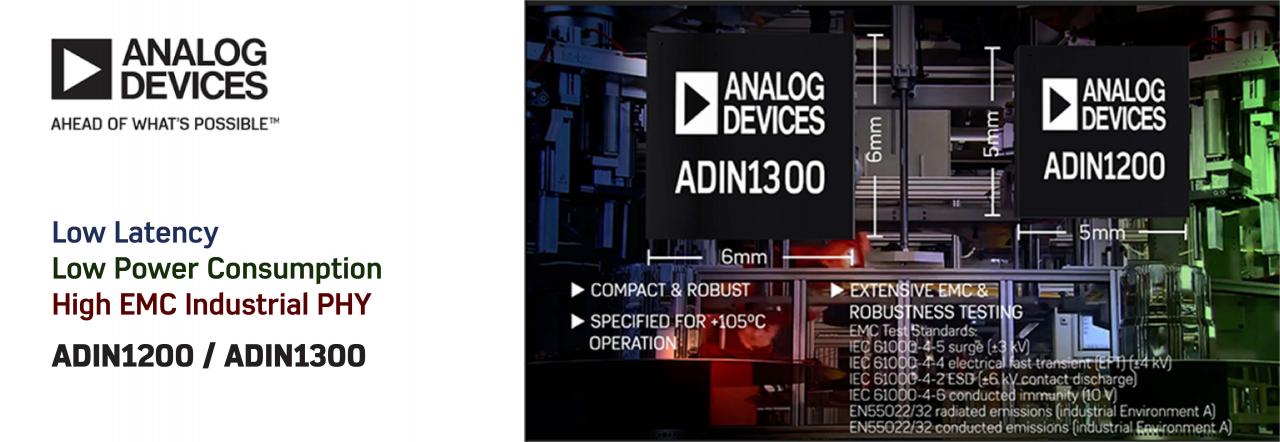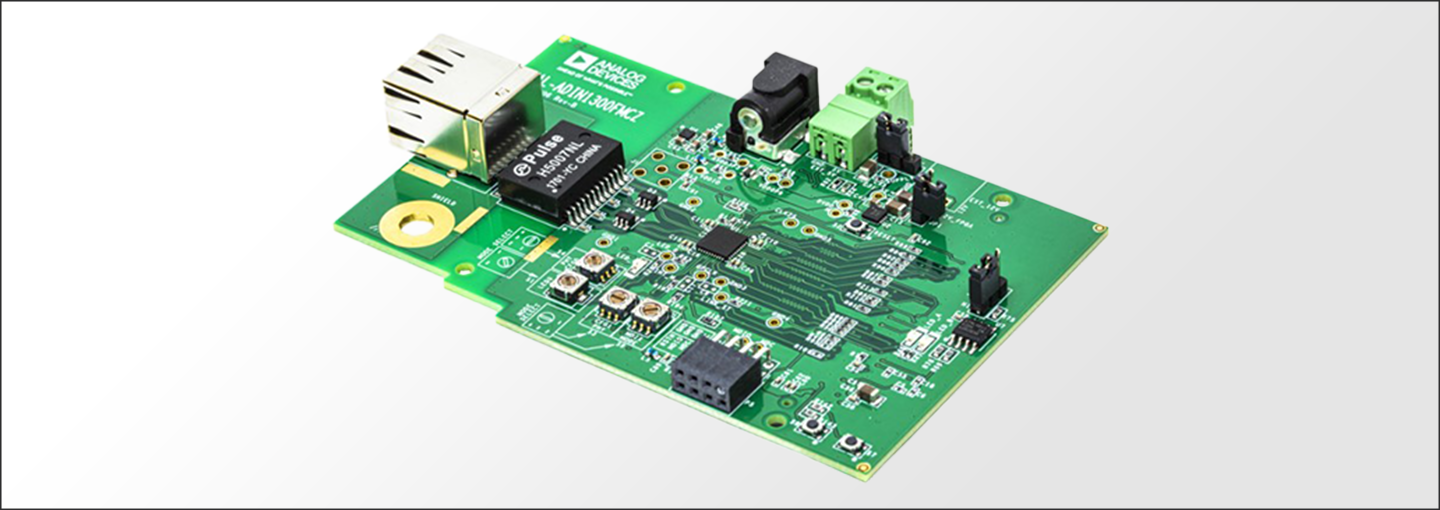Low latency, low power consumption, high EMC industrial PHY ADIN1200/ADIN1300

What characteristics are required for the physical layer (PHY) of industrial Ethernet?
Ethernet has evolved greatly since its introduction in the 1970s and is now widely used mainly in office networks. Industrial Ethernet is a technology that supports information communication that is increasing every day in Industry 4.0, which has been accelerating in recent years.
Industrial ethernet must be more robust than standard office ethernet to ensure that certain data can be transmitted and received accurately, even in harsh industrial environments such as high temperatures, vibration, noise, and noise.
Analog Devices's industrial Ethernet PHY ADIN1200 and ADIN1300 provide more accurate and reliable industrial Ethernet communications with the following three features.
- Industry-leading delay performance
- Operating temperature range and EMC characteristics for industrial applications
- Low power consumption suitable for airtight environments
Industry-leading delay performance
The ADIN 1200 and ADIN 1300 provide industry-leading low latency performance.
This reduces network cycle time, improves network refresh time, and allows more devices to connect to the network, thereby increasing operational control and security requirements for industrial Ethernet. The delay performance of ADIN 1200 and ADIN 1300 is specified as follows, and the delay is reduced by approximately 20% or more compared with other manufacturers.
ADIN1200
| Transmission system | Min | Typ | Max | |
|---|---|---|---|---|
| 100BASE-TX MII | TX Latency | 52ns | ||
| RX Latency | 248ns | |||
| Total Latency | 300ns | |||
| 100BASE-TX RGMII(1) | TX Latency | 84ns | 88ns | 92ns |
| RX Latency | 250ns | |||
| Total Latency | 334ns | 338ns | 342ns | |
| 100BASE-TX RGMII(2) | TX Latency | 84ns | 104ns | 124ns |
| RX Latency | 250ns | |||
| Total Latency | 334ns | 354ns | 374ns | |
| 100BASE-TX RMII | TX Latency | |||
| RX Latency | ||||
| Total Latency |
(1) Tx FIFO is programmed for synchronous operation.
(2) The MAC transmit clock does not need to be synchronized with the ADIN1200 reference clock and the Tx FIFO.
ADIN1300
| Transmission system | Min | Typ | Max | |
|---|---|---|---|---|
| 1000BASE-T RGMII | TX Latency | 60ns | 64ns | 68ns |
| RX Latency | 226ns | |||
| Total Latency | 286ns | 290ns | 294ns | |
| 100BASE-TX MII | TX Latency | 52ns | ||
| RX Latency | 248ns | |||
| Total Latency | 300ns | |||
| 100BASE-TX RGMII(1) | TX Latency | 84ns | 88ns | 92ns |
| RX Latency | 250ns | |||
| Total Latency | 334ns | 338ns | 342ns | |
| 100BASE-TX RGMII(2) | TX Latency | 84ns | 104ns | 124ns |
| RX Latency | 250ns | |||
| Total Latency | 334ns | 354ns | 374ns | |
| 100BASE-TX RMII | TX Latency | 72ns | 92ns | |
| RX Latency | 328ns | 348ns | 368ns | |
| Total Latency | 400ns | 430ns | 460ns |
(1) Tx FIFO is programmed for synchronous operation.
(2) The MAC transmit clock does not need to be synchronized with the ADIN1300 reference clock and the Tx FIFO.
Operating temperature range and EMC characteristics for industrial applications
ADIN1200/ADIN1300 are guaranteed to operate over a wide temperature range. It also complies with a wide range of EMI, EMC, and ESD standards, providing robust performance in harsh factory environments.
| ADIN1200 | ADIN1300 | |
|---|---|---|
| Communication speed | 10BASE-T 100BASE-TX IEEE® 802.3™ |
10BASE-Te 100BASE-TX 1000BASE-T IEEE® 802.3™ |
| MAC Interface | MII/RMII/RGMII | MII/RMII/RGMII |
| Package | 32-lead LFCSP | 40-lead LFCSP |
| Operating temperature range | -40℃ ~ +105℃ | -40℃ ~ +105℃ |
| EMC Test Compliance | IEC 61000-4-5 Surge (±3kV) IEC 61000-4-4 Electric Fast Transient (EFT) (±4kV) IEC 61000-4-2 ESD (±6kV contact discharge) IEC 61000-4-6 Conduction resistance (10V) EN55032 Radiated disturbance (Class A) EN55032 Conduction Radiation (Class A) |
IEC 61000-4-5 Surge (±3 kV) IEC 61000-4-4 Electric Fast Transient (EFT) (±4kV) IEC 61000-4-2 ESD (±6kV contact discharge) IEC 61000-4-6 Conduction resistance (10 V) EN55032 Radiated disturbance (Class A) |
Low power consumption for airtight environments
Many industrial applications are sealed to protect internal devices from dust, dirt, moisture, and water. Therefore, there is no airflow to dissipate heat from the device, so power consumption must be considered in the design.
Low power consumption is an important factor in addition to a wide operating temperature range, especially for industrial applications with high ambient temperatures.
The power consumption of ADIN1200/ADIN1300 is regulated as follows. The power consumption is reduced by approximately 30% or more compared with other products.
| Transmission scheme (RGMII) | Power Consumption (typ) | I/O supply voltage | |
|---|---|---|---|
| ADIN1200 | 100BASE-TX | 175mW | 3.3V |
| 155mW | 2.5V | ||
| 139mW | 1.8V | ||
| ADIN1300 | 1000BASE-T | 425mW | 3.3V |
| 370mW | 2.5V | ||
| 332mW | 1.8V | ||
| 100BASE-TX | 159mW | 3.3V | |
| 148mW | 2.5V | ||
| 140mW | 1.8V |
Easy-to-use evaluation board for ADIN1200/ADIN1300 key functions
The ADIN1200/ADIN1300 have a 5V single power supply evaluation board for easy evaluation of key functions. The evaluation board provides a FMC for connection to the master FPGA system for MAC interface and MDIO control.
You can also control MDIO with the optional MDIO interface dongle that includes the included ADuCM3029.

The main functions of ADIN1200/ADIN1300 are as follows.
- 10BASE-Te/100BASE-TX IEEE® 802.3™ compliant MII, RMII and RGMII MAC interfaces (ADIN1200)
- 10BASE-Te/100BASE-TX/1000BASE-T IEEE® 802.3™ compliant MII, RMII and RGMII MAC interfaces (ADIN1300)
- 100BASE-TX RGMII delay : TX <124 ns, RX <250 ns (ADIN1200)
- 100BASE-TX MII delay : TX <52 ns, RX <248 ns (ADIN1200)
- 1000BASE-T RGMII delay : TX <68 ns, RX <226 ns (ADIN1300)
- 100BASE-TX MII delay : TX <52 ns, RX <248 ns (ADIN1300)
- EMC testing standards :
- IEC 61000-4-5 Surge (±3kV)
- IEC 61000-4-4 Electric Fast Transient (EFT) (±4kV)
- IEC 61000-4-2 ESD (±6kV contact discharge)
- IEC 61000-4-6 Conduction resistance (10 V)
- EN55022 Radiated disturbance (Class A)
- EN55022 Conductive Radiation (Class B)
- Non - management configuration using multi - level pin straps
- IEEE 802.3 az compliant Energy Efficient Ethernet (EEE)
- IEEE 1588 Start-of-Frame Detection
- Configurable LED
- Crystal oscillator / 25 MHz clock input (50 MHz for RMII)
- 5MHz/125MHz synchronous clock output
- Small package and wide operating temperature range
- 32 - pin (5 mm x 5 mm) LFCSP(ADIN1200)
- 40 - pin (6 mm x 6 mm) LFCSP(ADIN1300)
- Operating specifications at ambient temperature of -40℃ ~ +105℃
- • Low power consumption
- 139 mW (100BASE-TX) 3.3V/2.5V/1.8 V MAC interface VDDIO power supply (ADIN1200)
- Single power supply operation : 3.3 V VDDIO (ADIN1200)
- 332mW(1000BASE-T)(ADIN1300)
- 140mW(100BASE-TX)(ADIN1300)
- 3.3V/2.5V/1.8 V MAC interface VDDIO power supply (ADIN1300)
- Integrated power monitor and POR
Application Example
- Factory automation
- Industrial robotics
- Building automation

